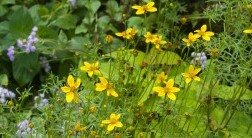Longing to visit Provence, that beautiful and charming region in the south of France, to bask in its warm sunlight, taste its delicious cuisine, and see the sloping vineyards and colorful scenery that charmed Cezanne and Van Gogh? Well, you can capture some of the ambiance of Provence by growing its famous culinary herbs in your garden.
Thyme, rosemary, marjoram, basil, savory, and bay leaf are all native to this hill country and are the hallmark of its cooking. Blends of these plants—called herbes de Provence—and other traditional aromatics are used to make tea; enhance salads and desserts; and season soups, sauces, stews, grilled fish and meats, roasted vegetables, pasta, and more.
Below is an elegant design for growing Provençal herbs in containers on a patio or deck. As some of the plants are simple in form, we suggest growing them in antique pots to augment the visual display.
Flowering annuals such as striped French marigolds (Tagetes patula) can be added for seasonal color. All the herbs featured here need full sun and well-drained soil.

- Jasminum sambac (Arabian jasmine)
This tender perennial produces highly fragrant white summer flowers, which make an exotic tea when added to hot water. USDA Zones 9–10. - Laurus nobilis (bay laurel)
The pungent leaves of this perennial are added to soups, sauces, and stews. Zones 8–9. - Rosmarinus officinalis Prostratus Group (rosemary)
This woody herb is great for grilling and is delicious on all meats and chopped in breads and vegetable dishes. Zones 8–10. - Anethum graveolens (dill)
This annual's fine, lacy, anise-flavored foliage is used to enhance fish dishes, dips, salads, and vegetable stews. - Mentha aquatica × piperata f. citrata 'Orange' (orange mint)
This mint's citrus-flavored leaves are wonderful in fruit salads, desserts, and iced tea. Zones 5–9. - Satureja hortensis (summer savory)
The mild, peppery leaves of this annual herb are used in stews, omelets, and soups.
- Ocimum basilicum (sweet basil)
A fragrant annual herb, basil produces sweet, anise-flavored leaves that are used to season pasta dishes, salads, and much more. - Artemisia dracunculus (French tarragon)
This herb produces licorice-flavored leaves that are used to enhance vinegars and meat dishes. Zones 4–7. - Salvia officinalis (garden sage)
This herb's soft, fuzzy leaves are used to make a delicious butter sauce and are great for poultry and stuffing. Zones 4–8. - Lavandula angustifolia 'Hidcote' (lavender)
The flowers of this shrubby perennial are often added to herbes de Provence blends and are also very tasty with ice cream and berries. Zones 5–8. - Origanum majorana (sweet marjoram)
The savory-sweet leaves of this tender perennial are wonderful in butters, tomato sauce, pizza, and vegetable and meat dishes. Zones 9–10. - Thymus vulgaris (French thyme)
The tiny leaves of this woody perennial provide the key flavor of the classic herbes de Provence blend. Zones 5–9.



